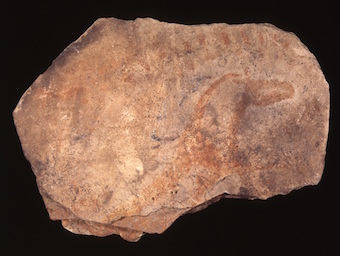
The analysis of the red and yellow pigments on the plaques in the Parpalló Cave (Gandía) show that they were obtained from natural iron oxides such as haematite and goethite. These compounds present themselves in combination with calcium carbonates, clays and quartz, whose presence is common in red and yellow soils. The study, published by the scientific journal ‘Plos One’ and developed by researchers of the Universitat de València using non-destructive techniques, constitutes the first characterisation of these pigments in one of the most important Palaeolithic sites in the Iberian Peninsula.
The Valencian scientists have analysed the plaques in the cave (limestones with flat surface and different thicknesses), which show on their surface zoomorphic, branch-shaped and geometric representations, painted with red and yellow pigments. The Parpalló Cave covers a chronology between 23 500 and 14 000 years ago and its archeologic material is formed by engravings and paintings made in more than 5 000 plaques of limestone that show the cultural expression of the hunter-gatherer societies of the Upper Palaeolithic of the peninsular Mediterranean arc.
Clodoaldo Roldán, ICMUV’s researcher, points that the figurative motifs were made with natural pigments based on red iron oxides (hematite), yellow iron oxides (goethite) and other unspecific iron oxides from the geographical environment of the Parpalló Cave.
The analyses were performed using energy-dispersive X-ray spectroscopy (XEDS) and spectrophotometry in the visible region, and have been carried out in situ in the Prehistory Museum of Valencia, where the pieces are stored. They complete another study carried out three years ago, which focused on the black pigments on the plaques in the same cave.
The study has also as an objective the analysis of the evolution of the pigments’ colour, checking if they degrade and how much they do it. The spectrophotometer (also named colorimeter) is the tool that details which tones have been used on the plaques of the Parpalló Cave. These chromaticity coordinates, analysed over time, will allow us to know if the drawings lose intensity or brightness and how much they do it. Currently the plaques from the archaeological site are in the Prehistory Museum of Valencia, in storage boxes or display cases. "If after a time there is no variation of the chromaticity coordinates, that means there is no colour degradation" completes Clodoaldo Roldán.
Valentín Villaverde, full university professor of Prehistory, Archaeology and Ancient History and member of the research team, has pointed that the results "confirm that in this site were used the same techniques and dyes that have been identified so far in the analysis of painted cave figures from the same timeline. This coincidence turns to be very interesting, since it is an argument of the similarity of the procedures used during the Palaeolithic in the portable and the cave art”.
Research
The work has been structured in three phases: the acquisition of experimental data, which was carried out in situ in the Prehistory Museum of Valencia; the analysis of the experimental data; and drawing conclusions concerning the red and yellow pigments that was performed in the ICMUV and the Department of Prehistory, Archaeology and Ancient History of the Universitat de València.
In order to analyse the pigments, made with a palette of basic colors (red and yellow), portable non-destructive techniques were used. The XEDS spectrometry was used to identify the elemental composition of pigments; and spectrophotometry was applied in order to record the chromaticity coordinates, the spectral reflectance curves of the pigments and study and evaluate the temporal evolution of colour. Additionally, detached microsamples of the plaques were analysed by infrared spectroscopy.
The research has born of a multidisciplinary collaboration between the ICMUV and the Department of Prehistory, Archaeology and Ancient History of the Universitat de València and it is developed in the framework of a project focused on the Middle and Upper Palaeolithic of the Spanish Mediterranean, whose objectives are the characterisation of raw materials and their management systems, the definition of lithic and bone operational chains and characterisation of dyestuffs, among others. The work has the support of the Ministry of Economy and Competitiveness and the Prometeo Programme of the Valencian Government.
Article:
Roldán García C, Villaverde Bonilla V, Ródenas Marín I, Murcia Mascarós S (2016) A Unique Collection of Palaeolithic Painted Portable Art: Characterization of Red and Yellow Pigments from the Parpalló Cave (Spain). PLoS ONE 10(12): e0144476. doi:10.1371/journal.pone.








